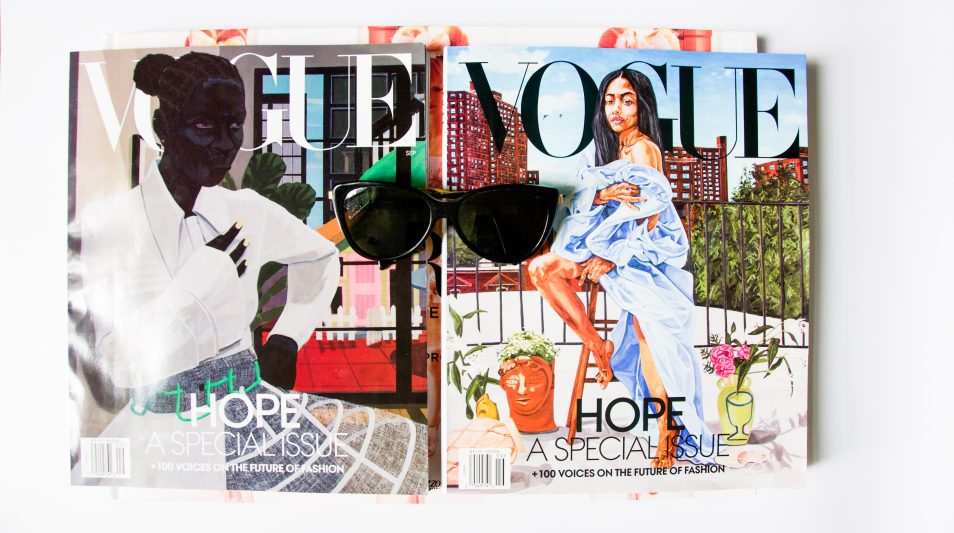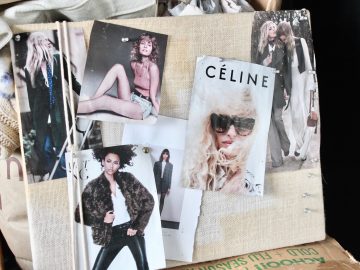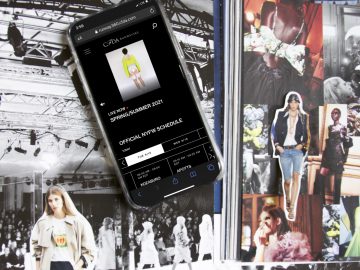Written by Amanda Vlavianos
The theme of this year’s ever coveted September Vogue stems from one core word in representation of 2020: HOPE.
For the first time in Vogue’s 128 year history, all 26 worldwide editions of the magazine have released covers that represent the positive vision of the future, hoping to unite the magazine’s millions of global readers. Anna Wintour, who needs no introduction, had much to say about the global decision, stating, “We all need hope in our lives, now more than ever, so at this tumultuous time, Vogue decided to bring all the global editions together around this optimistic, humane, forward-looking theme. Hope may be hard to find at a moment of crisis, but it also feels more essential than ever. It’s a part of our shared humanity, a source of delight and inspiration, and keeps us focused on a brighter future.”
American Vogue has released not one, but two covers, both by world-renowned painters who were given full freedom to interpret the theme as they wish. The two contemporary artists, Kerry James Marshall and Jordan Casteel, were employed to create paintings which had but one requirement: that the subject, real or imaginary, wear a dress by one of four designers selected by Vogue.
Kerry James Marshall, an American painter, has long created work in his 64 years that shines light on the unique aspects of African American culture in the United States. Most recently, in 2016/2017, his work was highlighted in a retrospective at the Metropolitan Museum of Art, showcasing nearly 80 works of art. For his cover, Marshall painted a fictional woman dressed in Virgil Abloh’s brand, Off-White, by way of an asymmetrical white evening dress (balanced by an accompanied asymmetrical pose). Marshall describes his character’s skin as being so dark that she is “at the edge of visibility,” showcasing a blackness that “is rich and complex.” Three different shades of paint were used to reach the desired level of darkness; carbon black; iron oxide black, also called mars black; and ivory black, also called bone black. Wait – did you think that’s all it took? Marshall then added cobalt blue, chrome green, carbazole dioxazine violet, yellow ochre, and raw sienna, stacking the colors on top of one another to reach the “very black, and very beautiful” end result.
A portrait of both simplicity and complexity, Marshall encourages the reader to look beyond the woman’s intensely dark skin tone to seek out the intricacies; her twisting braided hair, small details on her lips, the intense gaze in her eyes, and pops of color in small gold earrings and a bright, pastel yellow nail polish. Through the window on the terrace, we see a small pink house with a white picket fence, perhaps a representation of the American dream, hoped for by one and all but systematically a major challenge for people of color in the United States.
At less than half Marshall’s age, Jordan Casteel, 31, an American figurative painter, has taken the art world by storm with intimate portraits of those she knows and complete strangers alike in her native Harlem and NYC. Her first solo museum exhibition at The New Museum showcased 40 of her works this year, but was disappointingly cut short due to COVID-19. In true Casteel fashion, the painter chose someone very real as the subject of her cover: Aurora James. The fashion designer became a potent household name back in June (just a few months ago, though it feels like much further back) through her 15 Percent Pledge which called on major retailers to support black-owned businesses. On inspiration in choosing Aurora as her subject, Casteel noted, “I believe that what Aurora is doing is hugely important in creating the long-term change that Black people deserve and this country owes us. I see her as a light in a lot of darkness, and a potential for hope, a representative of change across all creative industries.”
On the cover, Aurora wears Pyer Moss, in what can only be called a masterpiece. Yards (and yards and yards) of blue silk cascade down as she leans on a tall stool, flowing effortlessly to reach the Brooklyn rooftop below her feet. Grounded with one bare foot upon the deck, a pink shoe lies astray beside her and a bright blue sky, complete with birds flying free in the notion of endless possibilities, hangs in the distance.
Adjacent to the Vogue September covers, Vanity Fair’s September cover features a portrait by painter Amy Sherald (you’ll remember her portrait of Michelle Obama) of Breonna Taylor, another woman who needs no introduction. A 26 year old black woman who was shot to death by multiple gunshots, unprovoked in her home, after her door was kicked in by Louisville police, has become a well-known face in the protests of police violence against people of color in the United States. The painting of Taylor on the cover of Vanity Fair sheds much-needed light on the massive systematic racial issues in the United States, especially in police brutality, of which Breonna Taylor and so many others have been an unnecessary victim. The special edition Vanity Fair issue was guest edited by Ta-Nehisi Coates to explore art, activism, and power and properly cover activism and call for change; bringing the same theme, but perhaps of a different tune, of HOPE to 2020.



